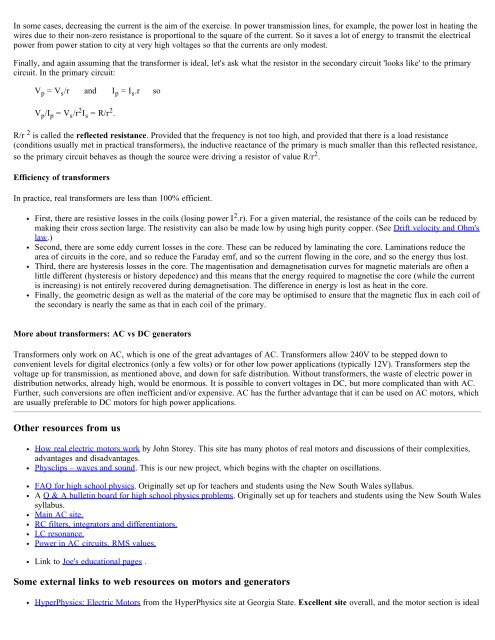How real electric motors work - School of Physics - The University of ...
How real electric motors work - School of Physics - The University of ...
How real electric motors work - School of Physics - The University of ...
Create successful ePaper yourself
Turn your PDF publications into a flip-book with our unique Google optimized e-Paper software.
In some cases, decreasing the current is the aim <strong>of</strong> the exercise. In power transmission lines, for example, the power lost in heating the<br />
wires due to their non-zero resistance is proportional to the square <strong>of</strong> the current. So it saves a lot <strong>of</strong> energy to transmit the <strong>electric</strong>al<br />
power from power station to city at very high voltages so that the currents are only modest.<br />
Finally, and again assuming that the transformer is ideal, let's ask what the resistor in the secondary circuit 'looks like' to the primary<br />
circuit. In the primary circuit:<br />
V p = V s /r and I p = I s .r so<br />
V p /I p = V s /r 2 I s = R/r 2 .<br />
R/r 2 is called the reflected resistance. Provided that the frequency is not too high, and provided that there is a load resistance<br />
(conditions usually met in practical transformers), the inductive reactance <strong>of</strong> the primary is much smaller than this reflected resistance,<br />
so the primary circuit behaves as though the source were driving a resistor <strong>of</strong> value R/r 2 .<br />
Efficiency <strong>of</strong> transformers<br />
In practice, <strong>real</strong> transformers are less than 100% efficient.<br />
First, there are resistive losses in the coils (losing power I 2 .r). For a given material, the resistance <strong>of</strong> the coils can be reduced by<br />
making their cross section large. <strong>The</strong> resistivity can also be made low by using high purity copper. (See Drift velocity and Ohm's<br />
law.)<br />
Second, there are some eddy current losses in the core. <strong>The</strong>se can be reduced by laminating the core. Laminations reduce the<br />
area <strong>of</strong> circuits in the core, and so reduce the Faraday emf, and so the current flowing in the core, and so the energy thus lost.<br />
Third, there are hysteresis losses in the core. <strong>The</strong> magentisation and demagnetisation curves for magnetic materials are <strong>of</strong>ten a<br />
little different (hysteresis or history depedence) and this means that the energy required to magnetise the core (while the current<br />
is increasing) is not entirely recovered during demagnetisation. <strong>The</strong> difference in energy is lost as heat in the core.<br />
Finally, the geometric design as well as the material <strong>of</strong> the core may be optimised to ensure that the magnetic flux in each coil <strong>of</strong><br />
the secondary is nearly the same as that in each coil <strong>of</strong> the primary.<br />
More about transformers: AC vs DC generators<br />
Transformers only <strong>work</strong> on AC, which is one <strong>of</strong> the great advantages <strong>of</strong> AC. Transformers allow 240V to be stepped down to<br />
convenient levels for digital electronics (only a few volts) or for other low power applications (typically 12V). Transformers step the<br />
voltage up for transmission, as mentioned above, and down for safe distribution. Without transformers, the waste <strong>of</strong> <strong>electric</strong> power in<br />
distribution net<strong>work</strong>s, already high, would be enormous. It is possible to convert voltages in DC, but more complicated than with AC.<br />
Further, such conversions are <strong>of</strong>ten inefficient and/or expensive. AC has the further advantage that it can be used on AC <strong>motors</strong>, which<br />
are usually preferable to DC <strong>motors</strong> for high power applications.<br />
Other resources from us<br />
<strong>How</strong> <strong>real</strong> <strong>electric</strong> <strong>motors</strong> <strong>work</strong> by John Storey. This site has many photos <strong>of</strong> <strong>real</strong> <strong>motors</strong> and discussions <strong>of</strong> their complexities,<br />
advantages and disadvantages.<br />
Physclips – waves and sound. This is our new project, which begins with the chapter on oscillations.<br />
FAQ for high school physics. Originally set up for teachers and students using the New South Wales syllabus.<br />
A Q & A bulletin board for high school physics problems. Originally set up for teachers and students using the New South Wales<br />
syllabus.<br />
Main AC site.<br />
RC filters, integrators and differentiators.<br />
LC resonance.<br />
Power in AC circuits, RMS values.<br />
Link to Joe's educational pages .<br />
Some external links to web resources on <strong>motors</strong> and generators<br />
Hyper<strong>Physics</strong>: Electric Motors from the Hyper<strong>Physics</strong> site at Georgia State. Excellent site overall, and the motor section is ideal
















